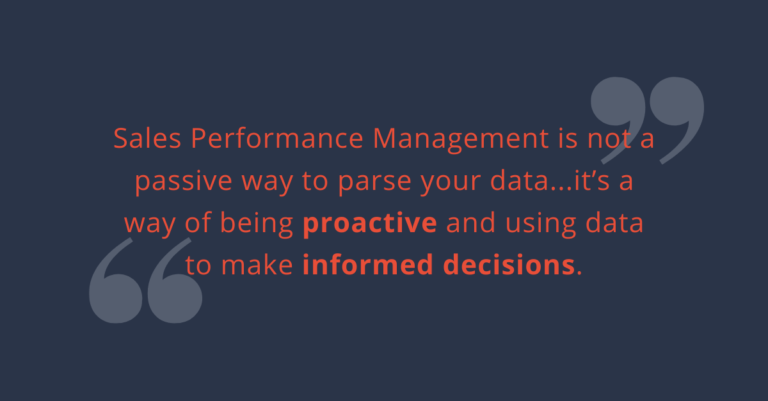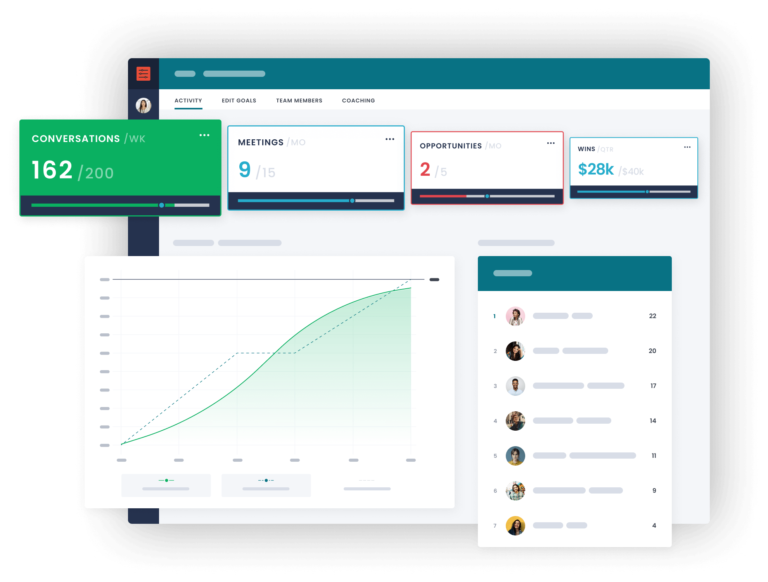
Sales Performance Management is a term that has many definitions, most of them complex and not really helpful for understanding what it actually is.
That’s a shame, because Sales Performance Management can be an incredibly powerful solution for a sales leader to implement in any organization. While it can look different for every sales team, the fundamental purpose of Sales Performance Management is improving the way your sales team works – and their results.
When it’s explained that simply, how could any good sales leader not see the importance of Sales Performance Management?
Sales Performance Management is all about adopting and operationalizing an effective performance management strategy. No matter your sales management style, you need to have a formalized strategy or process in place if you want to succeed.
With this guide, we’ll answer all the questions you could possibly have about Sales Performance Management. You’ll learn everything you need to know, including:
Sales Performance Management is a set of processes that optimize the measurement, analysis and development of sales input & output. The main objective of this disciplined approach to managing a sales team is to improve salesperson performance and drive successful business outcomes.
Essentially, Sales Performance Management is a big, overarching methodology that is made up of many individual processes aimed at optimizing activities and business goals. In this guide, we’ll help you narrow down this daunting idea by breaking it up into manageable, bite-size pieces.
Sales Performance Management includes multiple elements that work together to form one overall strategy for driving continuous improvement. These processes can be categorized into three core pillars of Sales Performance Management:
A company uses Sales Performance Management to set goals, collect and analyze data to decide which activities are providing results (and which are not), and help develop their sales force with one-on-one training and mentorship.
One of the foremost thought leaders on sales management, Jason Jordan, has a foundational book that every sales leader should read: Cracking the Sales Management Code: The Secrets to Measuring and Managing Sales Performance. It provides an in-depth understanding of the keys to becoming a successful sales leader.
One of those keys is an effective sales management strategy. As Jordan explains, “Companies with more developed sales processes enjoy greater sales performance.” This is because, when you have effective sales processes in place to guide your efforts, you and your team are in a better position to influence the critical metrics and activities that produce your desired business results. Per Jordan:
“Research consistently confirms that better sales processes equal better sales performance.”
Sales Performance Management is not a passive way to parse your data, and the software solutions that support Sales Performance Management aren’t simply activity trackers – it’s a way of being proactive and using data to inform decisions.
Sales Performance Management includes “management” because there is an active role to be played in improving sales performance. The key to driving continuous improvement is to apply the insights from performance data to the way your team works, and to evolve your existing processes to account for these learnings.

Still a little unclear on how it all works? Imagine this scenario:
So you have millions of data points around salesperson activities and goals, with a hundred-plus dashboards to monitor their progress towards goals. Great. Now what do you do with all that data? (This is one of the most common mistakes a sales leader makes – they measure sales performance while neglecting to actually manage it.)
Let’s say you’re a sales manager with 10 reps under you, and your forecasting shows your team is far off from achieving their goals for the quarter. While investigating the source of this problem, you recognize that two of those reps are far surpassing their monthly goals, while two others are significantly behind.
You wouldn’t sit there and do nothing, right?
You would try to find out what it is that has made those top performers so successful, and try to channel that into the lower performers. This means you have to teach the lower performers the best practices you identified from the top performers – you have to coach them.
With some coaching, those bottom two performers begin to improve their performance and start making their numbers. Seeing this success, you include those best practices in your training and development efforts for the rest of the team. Soon, you’ve lifted the entire team’s performance month-over-month, and the revenue goals your team had set are on track to be met and then some.
That’s sales performance management.
Now, let’s take a closer look at each of the elements that make up Sales Performance Management:
Perhaps the most critical element of a Sales Performance Management strategy is visibility, because if you can’t see what your sales team is doing, you can’t make improvements.
If you want to drive success from your sales team, you need a way to monitor your team’s performance toward their goals at both the individual and team level. This serves two purposes.
First, you can only identify a problem if you have visibility into what your sales reps are doing, i.e. sales activities. It is imperative that you monitor and measure important metrics and Key Performance Indicators.

Second, to understand what leads to success, analyze the activities and tactics of top performers to surface actionable insights. You need to pinpoint what it is they have done differently than everyone else to achieve higher success.
There are many ways to monitor these activities, but the best option is to use visualization tools like scorecards and leaderboards. Scorecards visualize data to provide an instant understanding of progress at the individual and team level.
Actionable insights like this allow you to take a deep look at your sales team’s performance and pinpoint the activities that drive achievement of objectives or goals, and how those objectives lead to the desired results.
Hint: learn how to build your own sales scorecard template in this guide.
Alternatively, these insights allow you to identify areas where the team is struggling and take action before it’s too late and you’ve missed your quota.
Once you’ve identified the behaviors that lead to success, it’s important to solidify them by motivating your sales reps to keep focusing on the right activities. Gamification is one of the best ways to get sales reps engaged and motivated to perform.

Create competitions with contests and leaderboards to motivate your team and generate excitement. Highlight important activities that are critical to successful behaviors.
Use tools for recognizing your team members who are performing well, and drive some healthy competition with leaderboards – whether tied to sales contests or just to show who is outperforming who toward monthly goals.
Remember what we said about being proactive, not just reactive? That comes into play with coaching and development. With real-time visibility into activities and performance, sales leaders have the opportunity to course-correct or initiate improvements before it’s too late.
Once you identify the activities and team members that need improvement, you can coach your sales reps on the successful behaviors you’ve uncovered from monitoring top performers.
And here’s some good news: research shows that your employees want to learn and improve. It isn’t just sales leaders that are placing increased importance on salesperson learning – the desire to improve skills is present on the employee side as well.

The best way for you to help your sales reps learn and improve their skills is to focus on consistent coaching. There are plenty of guides out there on how to effectively coach your team, but all of them stress the same thing: coaching is only effective if it is a consistent part of your daily routine.
This could mean setting up recurring one-on-ones with reps to help them work towards goals, or starting a weekly cadence of sitting in on calls and providing feedback and tips for improvement afterwards. Another opportunity for coaching is during the onboarding period for new hires – you can build out success plan templates that give new reps a clear and structured plan so they know what’s expected of them.
Whatever approach you take to coaching and developing your team, it’s important to be consistent and to document your follow-ups.
Now that you know what Sales Performance Management is, it’s important that you understand what it is not. Effective Sales Performance Management does not look like the following:
Although we advocate for sales activity tracking, that isn’t to say you should go overboard and create a culture of micromanaging your employees. Done properly, Sales Performance Management will lead to proactive management of your sales team – not micromanagement.
There are solutions or technologies available that enable managers to collect this data in an unobtrusive way that results in increased visibility overall and don’t give off the feeling that you’re looking over your reps’ shoulders.
While contests bring a spark of excitement and energy, they aren’t enough to ensure success in the long term when used as a one-off.
Sales Performance Management requires a holistic approach to create sustainable improvements in your sales team’s processes and results. If you rely solely on contests and prizes, behaviors will not be reinforced and will return to the old ways of doing things.
You need to support these desired behavioral changes with metrics, tools and skills that will reinforce these improvements.
Sales Performance Management and any software solutions that enable it should not complicate you or your sales teams’ jobs beyond what seems reasonable and justified. This should not lead to process overkill.
If the process requires more effort than you or your reps believe it is worth, you will never have successful adoption.
Developing a systematic and disciplined approach to Sales Performance Management is the only way to guarantee success – but that can be hard to sustain. Luckily, there are software solutions out there that can help.
In his book, Jordan reminds us that “Sustainable changes in behavior are achieved only if the entire system surrounding the salesperson is designed to support and reinforce the desired behaviors.” (177-178)
This really hits the nail on the head as to why software solutions are so important to Sales Performance Management. Sales Performance Management platforms or software solutions help drive the things that your team is already doing every day to encourage the success-building behaviors & activities.
If you build the right behaviors and have solid processes around things like coaching and follow-up, and you incentivize the right activities, you’re going to see positive results. As Jordan states:
“If you don’t support your desired behavioral changes with new metrics, tools, and skills to reinforce and measure the change, your sales force will quickly revert to its previous state.”
Implementing a Sales Performance Management software solution is beneficial for multiple reasons. It helps to:
Plus, it isn’t only sales leaders who Sales Performance Management software will help. If you can make the metrics easily visible, employees can self-diagnose their issues and seek out help on their own.
From SDRs to AMs and AEs, and even CSMs, everyone benefits from clarity around what is expected of them and what it will take to achieve the goals their leaders have set for them.
But don’t just take our word for it. Hear from actual Sales Performance Management software users in their reviews of LevelEleven:
This is a question we hear often from prospects: how do I know which Sales Performance Management software solution is best for my team? So we put together a quick guide to choosing the right Sales Performance Management process solution for your team.
First, consider the “single source of truth” approach: isn’t it important to get your tech stack simplified and have all your info in one place? If so, you’ll want a solution that pairs with (or is native to) your CRM so that you can centralize your performance management approach within your tech stack.
When vetting Sales Performance Management software providers, be aware of how their solution fits with the processes you already have in place. Many Sales Performance Management vendors have out-of-the-box solutions that aren’t tailored to fit your existing processes. But usually, one size does not fit all.
Make sure your process and any supporting tools are highly customizable to fit the way you and your team work, not the other way around. If you don’t, you risk losing momentum and adoption with the ultimate result of returning to old ways/the status quo.
Sales Performance Management must be “…supported by associated training, tools & metrics to have any chance at sustainability” (Jordan, 182), so carefully consider what your existing process looks like and how a solution like Sales Performance Management software would fit into the way your team works.
Alright, now you understand what Sales Performance Management is, what it is not, and how Sales Performance Management software solutions fit into all of this. But what are best practices for something like this? It’s a big undertaking, so you want to get it right.
Your Sales Performance Management methodology and supporting software solutions should accomplish a few vital things:
If you have all of this, you’re off to a great start to improving your team’s sales performance. With the right approach to Sales Performance Management and the solutions that support it, you’ll start to see the results in no time.
Ultimately, an effective Sales Performance Management methodology & supporting software will enable you as a sales manager to take action in the moment and make the right (data-informed) decisions that lead to success.
To recap, Sales Performance Management is a set of processes to measure, analyze and improve your sales team’s input and output. To take things a step further, implementing a Sales Performance Management software solution will achieve the following:
The best approach to Sales Performance Management is to put the focus on driving continuous improvement in your people. It’s all about aligning people to desired business outcomes, and that starts with optimizing your processes to build a culture that helps sustain these behaviors.
You’ve already invested heavily in your sales force, from your tech stack to your people, so it’s in your best interest to further that investment by improving and building your sales force’s capabilities and performance.
While it may look different for nearly every organization, as any good sales leader knows, better people + better processes = the best results.